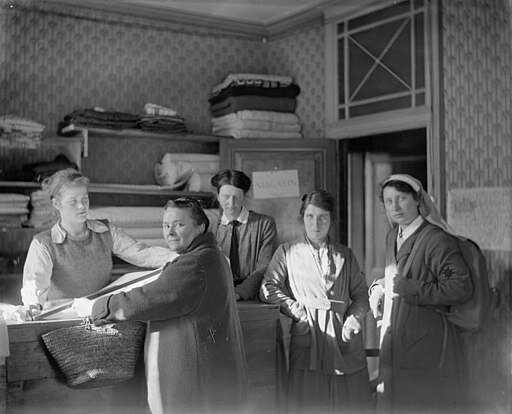In the spirit of International Women’s Day, we take a look at multitude of influential women hailing from Norfolk.
International Women's Day (March 8) is a global day celebrating the social, economic, cultural and political achievements of women. The day also marks a call to action for accelerating gender parity.
International Women's Day (IWD) has occurred for well over a century, with the first IWD gathering in 1911 supported by over a million people in Austria, Denmark, Germany and Switzerland. Prior to this the Socialist Party of America, United Kingdom's Suffragists and Suffragettes, and further groups campaigned for women's equality.
Boudicca - Queen of the Iceni
Died 60/61 AD
The statue of Boudicca and her daughters has stood at Westminster Bridge since 1902
No machine-readable author provided. Lily15 assumed (based on copyright claims). / CC BY-SA
Boudicca is a symbol of female strength, ruling the Iceni tribe across Norfolk eastern Cambridgeshire and North Suffolk, along with her husband, King Prasutagus. The Romans invaded in 43 AD, allowing Prasutagus to continue to rule his people alongside them; when he died he left half is empire to the Roman emporer Nero and the other half to his wife and daughters. The Romans invaded Boudicca and her people, inciting a rebellion led by Boudicca and the Iceni, who went on to destroy Londinium (London) and Verulamium (St Albans); thousands of people are said to have died. The Iceni eventually succumbed to the Romans, and Boudicca is said to have poisoned herself to escape capture.
The site of a Roman Town, Venta Icenorum (Market place of the Iceni) stands at Caistor St Edmund, just outside Norwich, where old town walls can still be seen. Similar sites of this time or later stand at Burgh Castle and Caister-on-Sea. You can also take a wander down the 36 mile nature path of Boudicca Way running from Norwich to Diss, or learn more about Boudicca and the Romans at Norwich Castle.
Anna Sewell - Author
1820 - 1878
Anna Sewell was born in a small house in Great Yarmouth, moving to London with her family soon after but frequently visiting family in Buxton, Norfolk. She suffered an injury to her ankles which left her with lifelong mobility problems, relying on horse drawn carriages to get around. She went on to write the classic novel “Black Beauty” from her bed in Norwich, which she sold to Jarrold & Sons in 1877, shortly before her death the next year. The book focuses on the life and treatment of horses and settings in the book possibly inspired by her family’s land in Norfolk; unfortunately she never lived to see the success of the book.
Anna was buried in a Quaker Cemetery in Lamas, near to Buxton, where her grave is inset into the walls of the house that stands there now. There is a memorial in the city set up by her cousin in 1917, as well as a college named after her on the outskirts of Norwich; there is also a plaque at the house she was born in, in Great Yarmouth.
Edith Cavell - Nurse
1865-1915
The original uploader was Vivedatica at Dutch Wikipedia. / Public domain
Born in Swardeston, a small village outside Norwich, Edith Cavell was a first world war hero sentenced to death by firing squad for helping soldiers on both sides. It is said she became a nurse after returning to Norwich from Belgium to care for her sick father; she was in Norwich when war broke out and returned to the continent, saying "at a time like this, I am more needed than ever".
It is believed she saved over 200 men, being heavily criticised for also helping soldiers from the German & Austrian side, who were fighting against the British. Her execution recieved worldwide press coverage and condemnation; British newspapers set up fundraising for nurses in her name, which lives on today as the Cavell Nurses’ Trust.
She is laid to rest at Norwich Cathedral, where you can visit her memorial and view paintings commissioned by Brian Whelan; there is also the Edith Cavell Pilgramage, a walking & cycle route from Swardeston to the Cathedral. Opposite the Cathedral, overlooking historic Tombland, is a gastropub named in her honour.
Olive Edis - Photographer
1876-1955
Edis, Olive / Public domain
Referred to as Britain’s First Female War Photographer, Olive Edis was born in London and took up photography in her twenties after being gifted a camera from her first portrait subject, her cousin Caroline. In 1905, Olive and her sister set up a photographic studio in Sheringham on the North Norfolk coast, built by their architect Uncle Robert William Edis, who was Deputy Lieutenant for Norfolk from 1901.
Over the course of her career she photographed a variety of subjects; from local fisherman to members of the Royal Family and in 1918 was commissioned to photograph women’s war work in Europe by the Imperial War Museum. There was opposition to sending a woman to photograph a warzone, however she embarked on a trip around France and Belgium alongside Lady Norman, Chair of the Women’s Work Committee.
The largest collection of her works can be seen in the Cromer Museum after years of her being all but forgotten; there is also an exhibition at Ancient House Museum of Thetford Life, running until 14 September 2019.
Norfolk is full of tales to tell of influential women and the history that followed them, with countless museums, churches and beautiful seaside and countryside. It’s the perfect place for a holiday home; you could explore whenever you want to!




